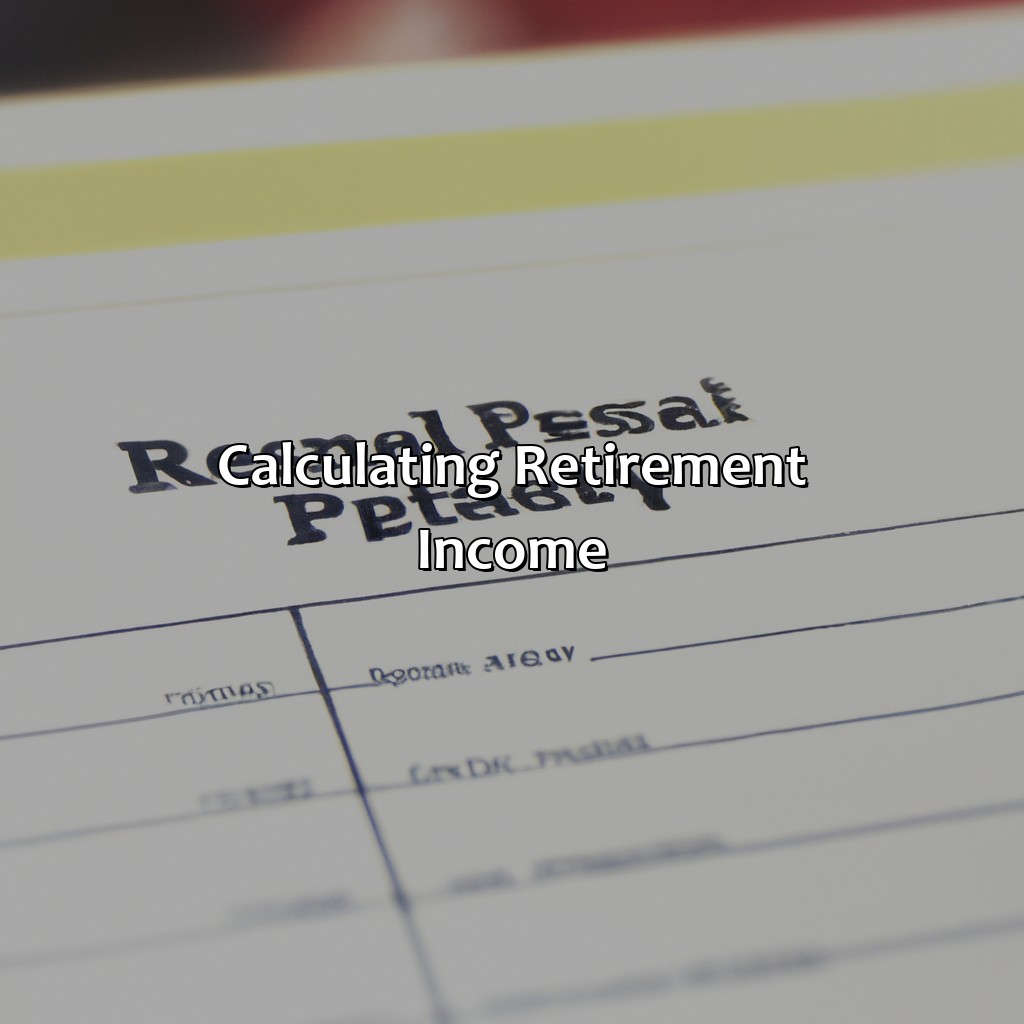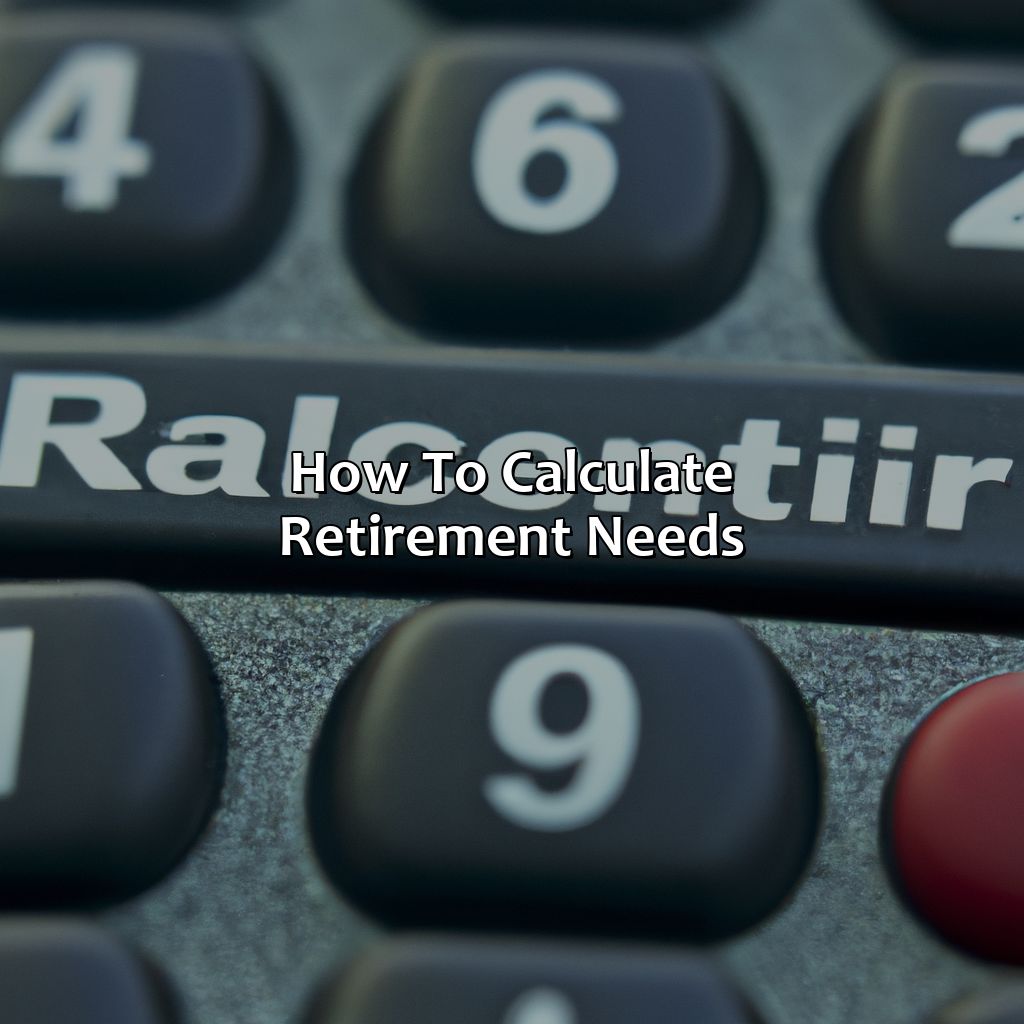How To Calculate Retirement Needs?
Key Takeaway:
- Estimating retirement expenses is crucial to determine retirement needs. This will include basic expenses, health care expenses, and leisure expenses. Understanding and budgeting for these expenses will help in calculating retirement savings needed.
- Retirement income can come from multiple sources like social security benefits, other sources of retirement income, and investment income. Proper estimation of these sources will provide a clear picture of the retirement savings needed.
- Calculating retirement savings required is essential to determine the retirement income gap. Adjusting for inflation and life expectancy is necessary to ensure that the retirement savings are capable of supporting an individual’s lifestyle. Developing a retirement savings plan is crucial for maximizing contributions, choosing appropriate investments, and monitoring and adjusting the plan as required.
Retirement can be a daunting journey, leaving you uncertain of your financial state. You need to plan for a secure future. With this guide, you can learn how to calculate your retirement needs and plan for a secure future.
Estimating Retirement Expenses
To work out your retirement costs, you need to factor in Basic Expenses, Health Care Costs and Travel and Leisure Expenses. Each one has a different effect on the total. Knowing all three will help you get a better idea of how much you’ll need for retirement.

Image credits: retiregenz.com by Adam Washington
Basic Expenses
Expenses for survival in retirement
Basic expenses refer to the necessary spending required for an individual’s survival during retirement. These are absolute needs and should be the priority when estimating retirement needs. They include housing, food and household supplies, transportation, healthcare, and insurance.
- Housing – Regular mortgage payments or rent expenses that consume a significant chunk of income in retirement should be avoided.
- Food and Household Supplies – A retiree’s grocery bill can significantly impact their finances if they are not careful about their spending habits.
- Transportation, healthcare, and insurance – These essential costs cannot be ignored while making an estimate of retirement finances.
It is essential to ensure that retirees allocate funds effectively for basic expenses during retirement as these expenses cover the day-to-day cost of living. An example of a retiree who made financial mistakes by neglecting their basic expense allocation was led to work well into their seventies just to make ends meet later on in life. Retirement planning: where you budget for your golden years and hope your health doesn’t bankrupt you.
Health Care Costs
When planning for retirement, it is important to consider the expenses associated with one’s healthcare. The cost of medical treatments and services can add up quickly and have a significant impact on retirement finances.
Healthcare expenses can include doctor visits, prescription medications, hospital stays, and long-term care. Medicare may not cover all these costs, so retirees should also look into supplemental insurance options or health savings accounts.
It is worth noting that healthcare costs tend to increase as individuals age. Therefore it is crucial to estimate these expenses in advance and consider any potential health issues that may arise.
Pro Tip: It is essential to regularly review your healthcare coverage and adjust as necessary throughout retirement to ensure adequate protection from unexpected medical bills.
Who needs expensive vacations when retirement homes come with all-inclusive bingo nights?
Travel and Leisure Expenses
For the section of your retirement expenses dedicated to fun and relaxation activities, it is essential to anticipate the costs involved. You want to make sure you have enough allocated funds for all your preferred destinations and hobbies.
Here are three points to consider when calculating your estimated expenses for travel and leisure:
- Plan for seasonal price fluctuations, as peak seasons tend to have higher rates.
- Factor in any additional costs associated with traveling abroad or engaging in expensive hobbies.
- Consider any potential medical expenses that may arise during these activities, such as travel insurance or health check-ups required before participation.
It’s important to note that even if you plan to stay close to home, there are still many enjoyable leisure activities that come at a cost. Anticipate expenses such as gym memberships, concert tickets, and dining out with friends.
Did you know? According to a study by Merrill Lynch and Age Wave, 72% of retirees report wanting to spend their money on experiences rather than material possessions.
Retirement income: the only time in life where the less you make, the more you have to budget.
Calculating Retirement Income
To work out retirement income, you need to know the details of Social Security Benefits, Other Sources of Retirement Income, and Investment Income. To help, we’ve split this into three sections. One section for each type of income. This will make it easier to figure out the essential components for calculating retirement income.

Image credits: retiregenz.com by James Washington
Social Security Benefits
Many individuals rely on Federal Assist for their post-retirement income sources. These benefits include contributions to retirement savings accounts and pensions, as well as Medicare and Medicaid benefits. Since social security payments usually represent a significant portion of the average retiree’s income, it’s important to know what you’ll be eligible for.
Through Social Security Benefits, retirees can receive regular monthly payments from the government. The amount you are eligible for depends on your average lifetime earnings, as well as the age at which you file for benefits. Factors like cost-of-living adjustments and spousal or survivor benefits also come into play.
While Social Security Benefits provide a foundation for your retirement income, they aren’t likely to furnish everything you need to live comfortably after stopping work. Thus it is advisable to plan ahead with other sources of cash flow such as personal savings and investment that can supplement your earnings.
According to history in 1935, President Franklin D. Roosevelt signed an act establishing social security as we know it today. This was intended primarily to provide retirement support and insurance protection during financial difficulties but has since evolved into various forms of aid offered by the government.
Who needs a pension when you have a side hustle selling artisanal jam at the local farmer’s market?
Other Sources of Retirement Income
Retirement Income from Various Sources
Retirement income comes from various sources other than savings and investments. Social Security payments, annuities, pensions, and inheritance are significant sources of retirement income. While pensions and Social Security payments offer guaranteed financial assistance post-retirement, annuities provide a steady stream of income. Inherited assets can also serve as retirement income sources.
To maximize retirement income from other sources, experts suggest purchasing an annuity with any additional funds and opting for an inflation-protected payout plan. Maintaining beneficiary designations and opting for spousal protection in pension payouts is essential to secure future financial security.
Planning for retirement is like investing in the stock market – you never know what the future holds, but diversification is key for a stable income.
Investment Income
Have a solid understanding of your financial goals with returns from investments. In addition to steady income, a literal meaning of creating Investment Income is to maximize profits through a diversified portfolio. Stay updated on market trends and investment opportunities.
A well balanced and diverse portfolio can increase the chances of gaining returns even in times of economic uncertainty. A literal meaning of Investment Income can be achieved by investing in bonds or stocks that offer consistent dividends or rental properties that provide steady income through tenancy agreements.
It’s crucial to avoid risk factors that could lead to losses or low returns such as putting all savings into one stock or selecting investments without studying the market first. To achieve maximum returns from your investment, use tools such as compound interest calculators for retirement planning.
Pro Tip: Consult a financial advisor before making any significant investment decisions.
Avoiding work today is like saving for retirement – procrastination now could lead to regret later.
Determining Retirement Savings Needs
To find out your retirement savings needs, look no further! Estimate the retirement income gap. Calculate the required savings. Account for inflation and life expectancy too.
This section, “Determining Retirement Savings Needs,” offers guidance on these key sub-sections. It will help you work out the exact amount of retirement savings you need.

Image credits: retiregenz.com by David Washington
Estimating Retirement Income Gap
Determining How Much Retirement Savings You Need
Calculating how much money you will need during your retirement years can be a daunting task, but it’s essential to plan ahead. One crucial aspect of this planning is estimating the gap between your projected retirement income and your expected expenses during this period.
Estimating Your Required Retirement Income
To determine your required retirement income, you need to consider factors such as inflation, healthcare costs, taxes and other expenses like home maintenance or travel. Based on these projections, compare your expected expenses with your available sources of retirement income, such as social security benefits, 401(k), IRA, or pension plans.
Closing the Gap
If the projected income is lower than what you will need for a comfortable lifestyle in retirement, there are various strategies to close the gap. These include lowering expenses by downsizing or reducing debt, delaying retirement until a later age when you have saved more money or increasing personal savings contributions.
Pro Tip: It’s vital to start planning for retirement early and review your plan periodically to ensure that it aligns with your current financial goals. Keeping track of market trends and adjusting investments accordingly can also help maximize returns and minimize risks in reaching retirement goals.
Retirement savings calculation: because guessing doesn’t count as a retirement plan.
Calculating Retirement Savings Required
Determining the required amount for retirement savings can be a daunting task, but it is essential in securing your financial future. Proper planning involves evaluating expenses, expected income, and life expectancy. The process involves using various tools and techniques to estimate expenses and revenues. Some of these include online calculators, investment software, or seeking professional financial advice.
It’s important to consider inflation rates when determining retirement savings needs as this could increase yearly expenses significantly. Using a percentage-based formula to calculate estimated expenses every year into retirement could be a useful tool. Ensuring that Social Security benefits are included in your calculations would give you an accurate estimate of expected income.
By thoroughly evaluating all sources of income leading up to retirement and estimating future projected costs, you can determine the amount of money needed in retirement savings. This ensures a steady stream of revenue while providing peace of mind that all expected expenses will be catered for comfortably.
Pro Tip: Saving cash in a high-interest account such as CDs or bonds may aid in complicating available funds over time while ensuring minimal risk loss.
Retirement planning is like a game of chess, just with less strategy and more napping.
Adjusting for Inflation and Life Expectancy
Taking into account the impact of inflation and life expectancy on retirement planning is of utmost importance. Adjusting for these factors ensures a realistic calculation of retirement savings needs.
Inflation erodes the purchasing power of money over time, hence it’s vital to consider future expenses at an inflated cost. Similarly, with increasing life expectancy, it becomes necessary to plan for longer periods in retirement.
Focusing on these vital factors also requires having a sound understanding of market fluctuations in interest rates or inflation. Seeking professional advice on the matter can help increase accuracy in calculating one’s retirement savings needs.
Neglecting to adjust for inflation and life expectancy can result in significant shortfalls in financial preparedness for retirees. It’s crucial to empower oneself with the right knowledge and tools to make informed decisions about one’s retirement savings plan.
Retirement savings plan: because living on cat food is no way to spend your golden years.
Developing a Retirement Savings Plan
Create a retirement savings plan with assistance! Use “Maximizing Retirement Contributions,” “Choosing Appropriate Investments,” and “Monitoring and Adjusting Retirement Plan.” These subsections can help. Simplify retirement planning. Access various solutions to help increase your retirement savings. Minimize investment risks. Monitor your retirement plan effectively.

Image credits: retiregenz.com by Adam Jones
Maximizing Retirement Contributions
Retirement Savings Strategies
To efficiently plan and maximize retirement savings, one must consider multiple factors. One way to increase contributions is by investing early on in IRA or 401(k) plans. Utilizing catch-up contributions can also assist in reaching retirement goals. Minimizing expenses can free up more funds to save. Tax-efficient planning is another crucial aspect as tax-free withdrawals can significantly improve your account balance. Lastly, finding alternative ways, such as real estate investments or rental income, to supplement income should be explored.
Additionally, it is recommended to consult with a financial advisor to help with specifics unique to your situation.
A possible example:
My colleague Mary began contributing just $100 a month into her IRA at age 25. Fast forward 40 years and she was able to accumulate over $227,000 in savings! She credits her financial advisor’s guidance for this accomplishment.
Investing in stocks is like taking a date to a horror movie, it can be scary but also exciting if you know what you’re doing.
Choosing Appropriate Investments
Investment Comprehension: After calculating your retirement needs, it’s important to select investments that align with your financial ambitions and degree of risk tolerance. High-risk investments have greater potential for returns but greater possibility of losses, whereas low-risk investments are more stable but generate lower returns. Your investment choices need to be thoroughly monitored and adjusted according to market conditions.
Investment Evaluation: To create a diversified portfolio, spread your capital among different types of assets such as stocks, bonds, mutual funds or real estate. Research on potential investment options and ascertain their historical performance by comparing them with related indices such as the S&P 500 Index or NASDAQ Composite. Be sure investments fit within a specific asset allocation strategy balancing long-term growth with income preservation.
In-Depth Insight: Developing an asset allocation plan is vital in ensuring contribution consistency while mitigating inherent marketplace risks. Rebalancing your portfolio at set intervals ensures incoming profits are properly aligned with each individual asset; high-performing investments should be distributed into weaker ones while also assessing tax implications.
True Story: Barron’s ranked Vanguard as the top fund family out of 67 companies evaluated for his index-focused funds’ superior returns. Vanguard clients were able to focus on opportunities in line with growing momentum for thematic trends like climate change, health care technology and cybersecurity.
If life gives you lemons, use them to make lemonade and invest the profits in your retirement plan – just don’t forget to monitor and adjust as needed.
Monitoring and Adjusting Retirement Plan
Once you’ve established a retirement savings plan, it’s crucial to regularly analyze and modify it to ensure you’re on track to meet your retirement goals. This process of monitoring and adjusting your retirement fund is essential for long-term success. Through constant reassessment, you can make confident decisions about your financial future.
Monitor your investment portfolio regularly to ensure that its performance is consistent with the returns you need for a comfortable retirement. You may need to adjust your investments by adding more aggressive or conservative assets depending on market conditions and changes in risk tolerance.
In addition, you should examine the amount of money you’re saving each month and make adjustments as necessary. If you find that you’re falling behind in savings, consider cutting expenses or increasing income streams. You may also want to reevaluate your retirement goals and make any necessary adjustments.
Remember, every individual’s financial circumstances are unique, so there isn’t a one-size-fits-all solution for monitoring and adjusting a retirement plan. Seek guidance from qualified professionals who can offer tailored advice based on your individual situation.
A friend of mine thought he had enough saved for an early retirement until he underwent a major health crisis. The unforeseen medical expenses threatened the viability of his savings account; he was forced to dip into his IRA years earlier than planned. Had he been routinely monitoring his plans over the years, this contingency could have been avoided.
Five Facts About How To Calculate Retirement Needs:
- ✅ Retirement needs depend on factors such as income, lifestyle, health, and life expectancy. (Source: Investopedia)
- ✅ A popular approach to estimating retirement needs is the 4% rule, which suggests withdrawing 4% of your savings each year. (Source: NerdWallet)
- ✅ Other approaches to calculating retirement needs include the replacement ratio method and the cost-of-living method. (Source: Forbes)
- ✅ Health care costs are a significant expense in retirement, and it’s essential to account for them in your calculations. (Source: U.S. News & World Report)
- ✅ Working with a financial advisor can help you determine your retirement needs and develop a plan to achieve them. (Source: The Balance)
FAQs about How To Calculate Retirement Needs?
How do I calculate my retirement needs?
To calculate your retirement needs, you need to determine your desired retirement lifestyle, estimate your retirement expenses, and develop a retirement income plan. Start by identifying your retirement goals and how you want to spend your retirement years. Then, factor in your expected living expenses, such as housing costs, food, transportation, healthcare, and leisure activities. Finally, determine your retirement income sources, including Social Security benefits, pension plans, 401(k) and IRA accounts, and other options.
What factors should I consider when calculating my retirement needs?
Several key factors should be considered when calculating your retirement needs. These include your current age, expected retirement age, life expectancy, expected inflation rate, investment returns, and rate of withdrawal. You should also consider any expected changes in your lifestyle or life circumstances, such as moving to a new location or starting a new career.
How much should I save for retirement?
The amount you should save for retirement depends on several factors, including your current age, expected retirement age, anticipated retirement lifestyle, and other factors. As a general rule, experts recommend saving at least 10% to 15% of your income for retirement. However, the specific amount will vary based on your individual circumstances and financial goals.
What retirement income sources should I consider?
There are several retirement income sources that you should consider, including Social Security benefits, pension plans, 401(k) and IRA accounts, and other savings and investment options. It is important to evaluate each option carefully and determine which ones will best meet your retirement income needs and goals.
Should I work with a financial planner to calculate my retirement needs?
Working with a financial planner can be a helpful way to ensure that you are accurately calculating and planning for your retirement needs. A financial planner can provide insights into the factors you need to consider, help you develop a retirement income plan, and provide ongoing guidance and support as you move towards retirement.
What other steps can I take to prepare for retirement?
In addition to calculating your retirement needs and creating a retirement income plan, there are several other steps you can take to prepare for retirement. These include paying down debt, building an emergency fund, investing in your health, and considering options for long-term care. It is also important to regularly review and adjust your retirement plan as your circumstances change over time.





